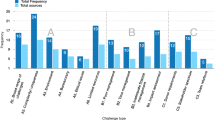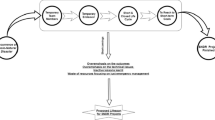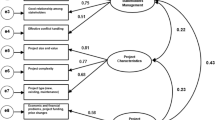Abstract
In this paper, we apply project management concepts and frameworks to the context of disaster resilience and examine how groups can increase the disaster resilience of a community. Based on our literature review and case study methodology, we develop a model that draws upon the relevant literatures in project management, operations management, disaster management, and organizational behaviour; we then compare that model with 12 disaster-related cases supported by four Non-Governmental Organizations (NGOs) in India. Our model measures disaster resilience using both an encompassing measure we refer to as Total Cost to Community (TCC) that captures the interrelatedness of level of recovery (deliverables), speed of recovery (time), and loss minimization (cost) at a community group level, as well as through learning (single domain or alternate domain). The model indicates that the external elements of the disaster management process (scale, goal complexity, immediacy, and stakeholder variance) influence the internal characteristics of disaster project management (information demands and uncertainty), which in turn influence disaster resilience. The level of community group processes (group strength, group continuity, and group capacity) also influences learning, both directly and indirectly, through internal characteristics of project management. In addition, the relationship between the external elements of disaster recovery and the internal characteristics of disaster project management is moderated by resources available. This model provides interesting new avenues for future theory and research, such as creating operations research models to identify the trigger points for groups becoming effective and exploring the quantification of TCC, a new construct developed in this research. Ultimately, this model can provide a roadmap for NGOs and government entities interested in building disaster resilience among micro-enterprises in vulnerable communities.


Similar content being viewed by others
References
Aldrich, D. P. (2012). Building resilience: Social capital in post-disaster recovery. Chicago: The University of Chicago Press.
Altay, N., & Green, W. G. (2006). OR/MS research in disaster operations management. European Journal of Operational Research, 175(1), 475–493.
Anaya-Arenas, A. M., Renaud, J., & Ruiz, A. (2014). Relief distribution networks: A systematic review. Annals of Operations Research, 223(1), 53–79.
Anbarci, N., Escaleras, M., & Register, C. A. (2005). Earthquake fatalities: The interaction of nature and political economy. Journal of Public Economics, 89(9), 1907–1933.
Arbon, P. (2014). Developing a model and tool to measure community disaster resilience. Australian Journal of Emergency Management, 29(4), 12.
Arouri, M., Nguyen, C., & Youssef, A. B. (2015). Natural disasters, household welfare, and resilience: Evidence from rural Vietnam. World Development, 70, 59–77.
Aughey, H., Duffin, W., Kyaw, T., & Zar, N. T. (2017). Goal-setting and performance feedback are effective tools for improving hand hygiene in a low resource pediatric health facility. Archives of Disease in Childhood, 102, A124–A125.
Bahinipati, C. S., & Patnaik, U. (2015). The damages from climatic extremes in India: Do disaster-specific and generic adaptation measures matter? Environmental Economics and Policy Studies, 17(1), 157–177.
Balbi, S., Giupponi, C., Olschewski, R., & Mojtahed, V. (2015). The total cost of water-related disasters. Review of Economics/ Jahrbuch Für Wirtschaftswissenschaften, 66(2), 225–249.
Barratt, M., Choi, T. Y., & Li, M. (2011). Qualitative case studies in operations management: Trends, research outcomes, and future research implications. Journal of Operations Management, 29(4), 329–342.
Berkes, F., & Ross, H. (2013). Community resilience: Toward an integrated approach. Society and Natural Resources, 26(1), 5–20.
Bhamra, R., Dani, S., & Burnard, K. (2011). Resilience: The concept, a literature review and future directions. International Journal of Production Research, 49(18), 5375–5393.
Bhattacharya, S., Mukhopadhyay, D., & Giri, S. (2014). Humanitarian relief supply chain in India-framework and challenges. Journal of Supply Chain Management Systems, 3(2), 32–40.
Blackman, D., Nakanishi, H., & Benson, A. M. (2016). Disaster resilience as a complex problem: Why linearity is not applicable for long-term recovery. Technological Forecasting and Social Change, 121, 59–77.
Bruneau, M., Chang, S. E., Eguchi, R. T., Lee, G. C., O’Rourke, T. D., Reinhorn, A. M., et al. (2003). A framework to quantitatively assess and enhance the seismic resilience of communities. Earthquake Spectra, 19(4), 733–752.
Carroll, A. B., & Buchholtz, A. K. (2012). Business and society: Ethics, sustainability and stakeholder management. Stamford: South-Western Cengage Learning.
Chang, K. (2010). Community cohesion after a natural disaster: Insights from a Carlisle flood. Disasters, 34(2), 289–302.
Chang, Y., Wilkinson, S., Seville, E., & Potangaroa, R. (2010). Resourcing for a resilient post-disaster reconstruction environment. International Journal of Disaster Resilience in the Built Environment, 1(1), 65–83.
Coombs, W. T. (2007). Ongoing crisis communication: Planning, managing, and responding. Los Angeles: Sage.
Crawford, L. H., Langston, C., & Bajracharya, B. (2013). Participatory project management for improved disaster resilience. International Journal of Disaster Resilience in the Built Environment, 4(3), 317–333.
David Swanson, R., & Smith, R. J. (2013). A path to a public–private partnership: Commercial logistics concepts applied to disaster response. Journal of Business Logistics, 34(4), 335–346.
Day, J. M., Melnyk, S. A., Larson, P. D., Davis, E. W., & Whybark, D. C. (2012). Humanitarian and disaster relief supply chains: A matter of life and death. Journal of Supply Chain Management, 48(2), 21–36.
de Gooyert, V., Rouwette, E., van Kranenburg, H., & Freeman, E. (2017). Reviewing the role of stakeholders in Operational Research: A stakeholder theory perspective. European Journal of Operational Research, 262(2), 402–410.
Eisenhardt, K. M. (1989). Building theories from case study research. Academy of Management Review, 14(4), 532–550.
Fox, S., & Grösser, S. (2015). Economical information and communication design for multi-national projects. International Journal of Managing Projects in Business, 8(3), 574–585.
Gabler, C. B., Richey, R. G., & Stewart, G. T. (2017). Disaster resilience through public-private short-term collaboration. Journal of Business Logistics, 38(2), 130–144.
Gunderson, L. (2010). Ecological and human community resilience in response to natural disasters. Ecology and Society, 15(2), 1–11.
Gupta, S., Starr, M. K., Farahani, R. Z., & Matinrad, N. (2016). Disaster management from a POM perspective: Mapping a new domain. Production and Operations Management, 25(10), 1611–1637.
International Strategy for Disaster Reduction Online Conference. (2004). Terminology. http://www.unisdr.org/2004/wcdr-dialogue/terminology.htm. Accessed 24 Mar 2017.
Kapucu, N. (2008). Collaborative emergency management: better community organising, better public preparedness and response. Disasters, 32(2), 239–262.
Kenis, P., Janowicz-Panjaitan, M., & Cambré, P. (2009). Temporary organizations: Prevalence, logic and effectiveness. Cheltenham: Edward Elgar Publishing.
Ketokivi, M., & Choi, T. (2014). Renaissance of case research as a scientific method. Journal of Operations Management, 32(5), 232–240.
Knowles, G., Luke, B., & Barraket, J. (2013). Investing and reinvesting in social capital: The spillover effects of social capital in self-help groups. Journal of International Development, 25(3), 438–441.
Kovács, G., & Spens, K. M. (2007). Humanitarian logistics in disaster relief operations. International Journal of Physical Distribution and Logistics Management, 37(2), 99–114.
Kumar, S., & Havey, T. (2013). Before and after disaster strikes: A relief supply chain decision support framework. International Journal of Production Economics, 145(2), 613–629.
Kunz, N., Reiner, G., & Gold, S. (2014). Investing in disaster management capabilities versus pre-positioning inventory: A new approach to disaster preparedness. The International Society for Inventory Research, 157, 261–272.
Le Masurier, J., Rotimi, J. O. B., & Wilkinson, S. (2006). A comparison between routine construction and post-disaster reconstruction with case studies from New Zealand. In Paper presented at 22nd ARCOM Conference on Current Advances in Construction Management Research, Birmingham, UK.
Learnard, C. (2011). Project management institute testifies on disaster relief project management. Project Management Institute. Available at: www.pmi.org.
Lei, L., Pinedo, M., Qi, L., Wang, S., & Yang, J. (2015). Personnel scheduling and supplies provisioning in emergency relief operations. Annals of Operations Research, 235(1), 487–515.
Lengnick-Hall, C. A., Beck, T. E., & Lengnick-Hall, M. L. (2011). Developing a capacity for organizational resilience through strategic human resource management. Human Resource Management Review., 21(3), 243–255.
Long, D. (1997). Logistics for disaster relief: Engineering on the run. IIE Solutions, 29(6), 26–30.
Long, D. C., & Wood, D. F. (1995). The logistics of famine relief. Journal of Business Logistics, 16(1), 213.
López-Marrero, T., & Tschakert, P. (2011). From theory to practice: Building more resilient communities in flood-prone areas. Environment and Urbanization, 23(1), 229–249.
Lucini, B. (2013). Social capital and sociological resilience in megacities context. International Journal of Disaster Resilience in the Built Environment, 4(1), 58–71.
Lundin, R. A., & Söderholm, A. (1995). A theory of the temporary organization. Scandinavian Journal of Management, 11(4), 437–455.
Mafuta, E. M., Hogema, L., Mambu, T. N., Kiyimbi, P. B., Indebe, B. P., Kayembe, P. K., et al. (2016). Understanding the local context and its possible influences on shaping, implementing and running social accountability initiatives for maternal health services in rural Democratic Republic of the Congo: A contextual factor analysis. BMC Health Services Research, 16(1), 640.
Manyena, S. B. (2006). The concept of resilience revisited. Disasters, 30(4), 434–450.
McCutcheon, D. M., & Meredith, J. R. (1993). Conducting case study research in operations management. Journal of Operations Management, 11(3), 239–256.
Meredith, J. (1998). Building operations management theory through case and field research. Journal of Operations Management, 16(4), 441–454.
Meyer, V., Becker, N., Markantonis, V., Schwarze, R., Van Den Bergh, J., Bouwer, L., et al. (2013). Assessing the costs of natural hazards-state of the art and knowledge gaps. Natural Hazards and Earth System Sciences, 13(5), 1351–1373.
Miller, R., & Hobbs, B. (2002). A framework for analyzing the development and delivery of large capital projects. In D. Slevin, D. I. Cleland, & J. Pinto (Eds.), The frontiers of project management research. Newton Square: Project Management Institute.
Mojtahedi, M., & Oo, B. L. (2017). The impact of stakeholder attributes on performance of disaster recovery projects: The case of transport infrastructure. International Journal of Project Management, 35(5), 841–852.
Molinari, D., Menoni, S., Aronica, G. T., Ballio, F., Berni, N., Pandolfo, C., et al. (2014). Ex post damage assessment: An Italian experience. Natural Hazards and Earth System Sciences, 14(4), 901–916.
Mota, C. M., De, Miranda, & de Almeida, A. T. (2012). A multicriteria decision model for assigning priority classes to activities in project management. Annals of Operations Research, 199(1), 361–372.
National Research Council. (2012). Disaster resilience: A national imperative. Washington, DC: The National Academies Press.
Noori, N. S., & Weber, C. (2016). Dynamics of coordination-clusters in long-term rehabilitation. Journal of Humanitarian Logistics and Supply Chain Management, 6(3), 296–328.
Norris, F. H., Stevens, S. P., Pfefferbaum, B., Wyche, K. F., & Pfefferbaum, R. L. (2008). Community resilience as a metaphor, theory, set of capacities, and strategy for disaster readiness. American Journal of Community Psychology, 41(1–2), 127–150.
OECD. (2013). What Does “Resilience” mean for donors? An OECD Factsheet. OECD.
Paton, D., & Johnston, D. (2017). Disaster resilience: An integrated approach. Springfield, IL: Charles C. Thomas Publisher.
Paul, J. A., & Hariharan, G. (2012). Location-allocation planning of stockpiles for effective disaster mitigation. Annals of Operations Research, 196(1), 469–490.
Pauwels, N., Van De Walle, B., Hardeman, F., & Soudan, K. (2000). The implications of irreversibility in emergency response decisions. Theory and Decision, 49(1), 25–51.
Pedraza-Martinez, A. J., & Van Wassenhove, L. N. (2016). Empirically grounded research in humanitarian operations management: The way forward. Journal of Operations Management, 45, 1–10.
Pimchangthong, D., & Boonjing, V. (2017). Effects of risk management practices on IT project success. Management and Production Engineering Review, 8(1), 30–37.
Poddar, K. K. (2013). Role of self help groups in economic empowerment of women in India. Anusandhanika, 5(1/2), 237–241.
Prasad, S., Su, H.-C., Altay, N., & Tata, J. (2015). Building disaster-resilient micro-enterprises in the developing world. Disasters, 39(3), 447–466.
Prasad, S., Tata, J., Herlache, L., & McCarthy, E. (2013). Developmental project management in emerging countries. Operations Management Research, 6(1–2), 53–73.
Prasad, S., Zakaria, R., & Altay, N. (2016). Big data in humanitarian supply chain networks: A resource dependence perspective. Annals of Operations Research. doi:10.1007/s10479-016-2280-7.
Preito, B., & Whitaker, C. (2011). Post disaster engineering and construction program and project management. PM World Today, 13(9), 1–19.
Prince, S. H. (1920). Catastrophe and social change, based upon a sociological study of the Halifax disaster (No. 212–214). Columbia University.
Rapp, R. (2011). Disaster recovery project management: Bringing order from chaos. West Lafayette, IN: Purdue University Press.
Romig, D. A. (1996). Breakthrough teamwork: Outstanding results using structured teamwork. Chicago, IL: Irwin Professional Publishing.
Rose, A. (2004). Defining and measuring economic resilience to disasters. Disaster Prevention and Management, 13(4), 307–314.
Rose, A., & Liao, S. Y. (2005). Modeling regional economic resilience to disasters: A computable general equilibrium analysis of water service disruptions. Journal of Regional Science, 45(1), 75–112.
Sagan, S. (1993). The limits of safety. Princeton: Princeton University Press.
Sahebjamnia, N., Torabi, S. A., & Mansouri, S. A. (2015). Integrated business continuity and disaster recovery planning: Towards organizational resilience. European Journal of Operational Research, 242(1), 261–273.
Scanlon, T. J., & Handmer, J. (2001). The Halifax explosion and the Port Arthur massacre: Testing Samuel Henry Prince’s ideas. International Journal of Mass Emergencies and Disasters, 19(2), 181–208.
Scholten, K., Pamela, S. S., & Fynes, B. (2014). Mitigation processes-antecedents for building supply chain resilience. Supply Chain Management, 19(2), 211–228.
Shenhar, A. J., & Dvir, D. (2004). How projects differ and what to do about it. In P. W. G. Morris & J. K. Pinto (Eds.), The Wiley guide to managing projects (pp. 1265–1286). New York: Wiley.
Söderlund, J. (2004). Building theories of project management: Past research, questions for the future. International Journal of Project Management, 22(3), 183–191.
Thomas, A. S., & Kopczak, L. R. (2005). From logistics to supply chain management: The path forward in the humanitarian sector. Fritz Institute Report. http://www.fritzinstitute.org.
TNCDW. (2000). Mahalir Thittam SHG working manual. http://www.tamilnaduwomen.org/publication.htm.
Tun, L. M., & Pathranarakul, P. (2006). An integrated approach to natural disaster management: Public project management and its critical success factors. Disaster Prevention and Management, 15(3), 396–413.
Voss, C., Tsikriktsis, N., & Frohlich, M. (2002). Case research in operations management. International Journal of Operations and Production Management, 22(2), 195–219.
Vugrin, E. D., Warren, D. E., & Ehlen, M. A. (2011). A resilience assessment framework for infrastructure and economic systems: Quantitative and qualitative resilience analysis of petrochemical supply chains to a hurricane. Process Safety Progress, 30(3), 280–290.
Yamamura, E. (2010). Learning effect and social capital: A case study of natural disaster from Japan. Regional Studies, 44(8), 1019–1032.
Zuo, K., Potangaroa, R., Wilkinson, S., & Rotimi, J. O. B. (2009). A project management prospective in achieving a sustainable supply chain for timber procurement in Banda Aceh, Indonesia. International Journal of Managing Projects in Business, 2(3), 386–400.
Author information
Authors and Affiliations
Corresponding author
Rights and permissions
About this article
Cite this article
Prasad, S., Woldt, J., Tata, J. et al. Application of project management to disaster resilience. Ann Oper Res 283, 561–590 (2019). https://doi.org/10.1007/s10479-017-2679-9
Published:
Issue Date:
DOI: https://doi.org/10.1007/s10479-017-2679-9




